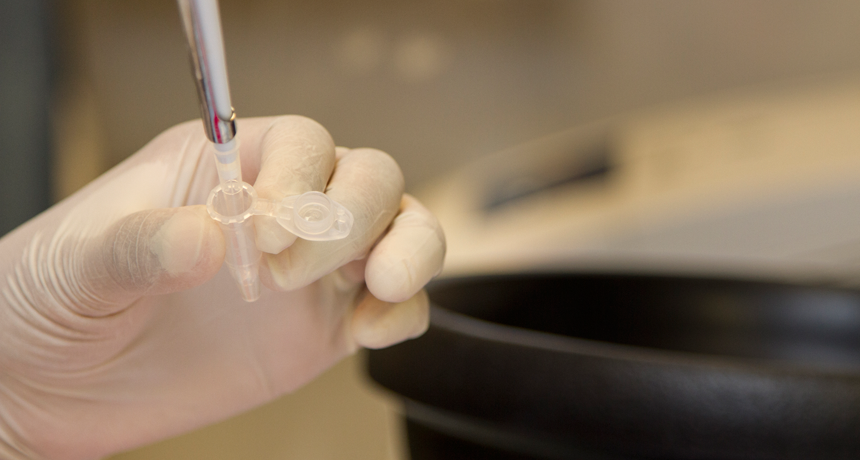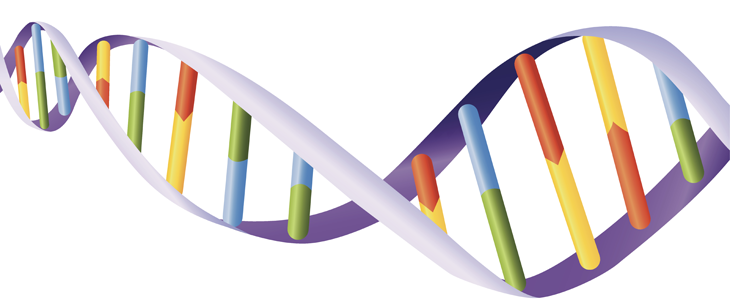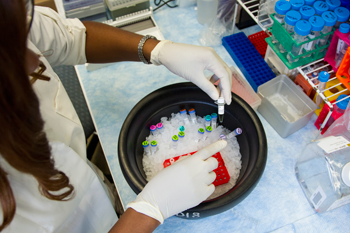Explainer: How PCR works
What a photocopier does for images and text on paper, PCR does for snippets of DNA

A researcher at the National Cancer Institute adds materials to a test tube before copying some segment of DNA using the polymerase chain reaction, or PCR.
Daniel Sone/NCI
Copy machines are handy in schools and offices because they can quickly duplicate pages from all types of sources. Similarly, biologists often need to make many, many copies of genetic material. They use a technology called PCR. It’s short for polymerase (Puh-LIM-er-ase) chain reaction. Within just a few hours, this process can make a billion or more copies.
The process starts with DNA, or deoxyribonucleic (Dee-OX-ee-ry-boh-nu-KLAY-ik) acid. It’s a playbook with instructions that tell each living cell what to do.
To understand how PCR works, it helps to understand the structure of DNA and its building blocks.
Each DNA molecule is shaped like a twisted ladder. Each rung of that ladder is made of two linked chemicals, known as nucleotides. Scientists tend to refer to each nucleotide as A, T, C or G. These letters stand for adenine (AD-uh-neen), thymine (THY-meen), cytosine (CY-toh-zeen) and guanine (GUAH-neen).
One end of each nucleotide holds onto an outside strand — or edge — of the ladder. The other end of the nucleotide will pair up with a nucleotide holding onto the ladder’s other outside strand. The nucleotides are picky about who they link up with. All A’s, for instance, must pair with T’s. C’s will pair only with G’s. Each letter is therefore the complement of the other in its pair. Cells use this picky pairing pattern to make an exact copy of their DNA when they divide and reproduce.
That pattern also helps biologists copy DNA in the lab. And they might want to copy only part of the DNA in a sample. Scientists can tailor which bit they copy using PCR. Here’s how they do it.
Story continues below image.

Heat, cool and repeat
Step one: Insert DNA into a test tube. Add in short strings of other nucleotides, known as primers. Scientists choose a primer that will pair with — or complement — a specific series of nucleotides at the end of the DNA bit they want to find and copy. For instance, a string of A, T and C will only pair with a T, C and G. Each such series of nucleotides is known as a genetic sequence. Scientists also throw into the mix a few other ingredients, including single nucleotides, the building blocks needed to make more DNA.
Now place the test tube into a machine that heats and cools these test tubes over and over again.
A normal piece of DNA is described as double-stranded. But before it prepares to reproduce itself, DNA will split down the middle of the ladder. Now the rungs separate in half, with each nucleotide remaining with its adjacent strand. This is known as single-stranded DNA.
With PCR technology, after the sample cools down again, the primers seek out and bind to the sequences they complement. Single nucleotides in the mix then pair up with the rest of the open nucleotides along the targeted single strand portion of DNA. In this way, each original bit of target DNA becomes two new, identical ones.
Each time the heating and cooling cycle repeats, it’s like pressing “start” on a copy machine. The primers and extra nucleotides duplicate the selected portion of DNA again. PCR’s heating and cooling cycles repeat over and over and over.
With each cycle, the number of target DNA pieces doubles. In just a few hours, there can be a billion or more copies.
PCR acts like a genetic microphone

Scientists describe this copying as amplifying the DNA. And that’s the real value of PCR. Think about walking into a crowded cafeteria. Your friend is sitting somewhere inside. If your friend saw you and said your name, you might not hear it above all the other students talking. But suppose the room had a microphone and sound system. If your friend announced your name over the mike, that voice would drown out all the rest. That’s because the sound system would have amplified your friend’s voice.
Similarly, after PCR has copied a selected bit of DNA in some sample, those over-represented copies will drown out everything else. The process will have copied the target snippets of DNA so many times that soon they vastly outnumber all of the rest of the genetic material. It’s like trying to pick out just the red M&Ms from a big bin. Picking out individual candies would take a really long time. But suppose you could double the red M&Ms over and over. Eventually, nearly every handful would contain just what you wanted.
Scientists use PCR for many types of work. For instance, scientists might want to see whether someone has a certain gene variation, or mutation. That altered gene might signal the person has a higher risk for a certain disease. PCR also can be used to amplify tiny bits of DNA from a crime scene. That lets forensic scientists work with the evidence and match it to other samples, such as DNA from a suspect. Environmental scientists might use PCR to see if any of the DNA taken from a river matches a particular species of fish. And the list goes on.
All in all, PCR is a really handy tool for genetics work. And who knows? Maybe one day you’ll find yet another use for this DNA copying machine.







